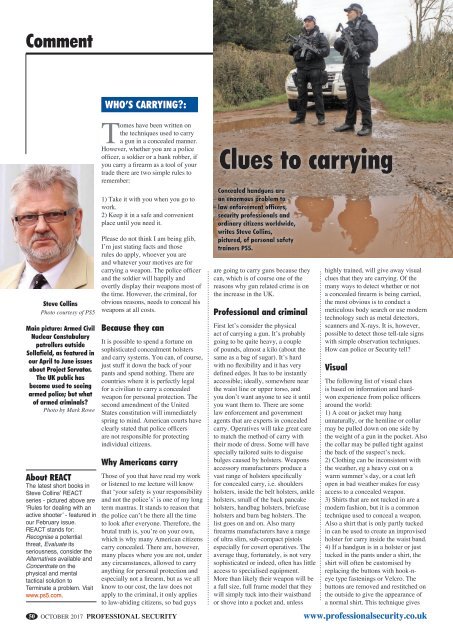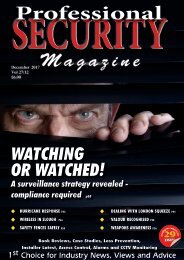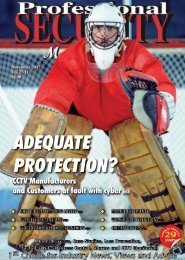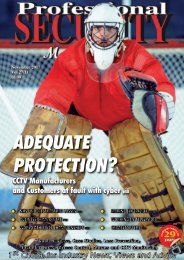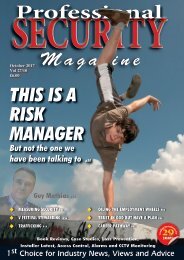27-10draft
You also want an ePaper? Increase the reach of your titles
YUMPU automatically turns print PDFs into web optimized ePapers that Google loves.
Comment<br />
who’s carrying?:<br />
About REACT<br />
The latest short books in<br />
Steve Collins’ REACT<br />
series - pictured above are<br />
‘Rules for dealing with an<br />
active shooter’ - featured in<br />
our February issue.<br />
REACT stands for:<br />
Recognise a potential<br />
threat, Evaluate its<br />
seriousness, consider the<br />
Alternatives available and<br />
Concentrate on the<br />
physical and mental<br />
tactical solution to<br />
Terminate a problem. Visit<br />
www.ps5.com.<br />
50<br />
Steve Collins<br />
Photo courtesy of PS5<br />
Main picture: Armed Civil<br />
Nuclear Constabulary<br />
patrollers outside<br />
Sellafield, as featured in<br />
our April to June issues<br />
about Project Servator.<br />
The UK public has<br />
become used to seeing<br />
armed police; but what<br />
of armed criminals?<br />
Photo by Mark Rowe<br />
Tomes have been written on<br />
the techniques used to carry<br />
a gun in a concealed manner.<br />
However, whether you are a police<br />
officer, a soldier or a bank robber, if<br />
you carry a firearm as a tool of your<br />
trade there are two simple rules to<br />
remember:<br />
1) Take it with you when you go to<br />
work.<br />
2) Keep it in a safe and convenient<br />
place until you need it.<br />
Please do not think I am being glib,<br />
I’m just stating facts and those<br />
rules do apply, whoever you are<br />
and whatever your motives are for<br />
carrying a weapon. The police officer<br />
and the soldier will happily and<br />
overtly display their weapons most of<br />
the time. However, the criminal, for<br />
obvious reasons, needs to conceal his<br />
weapons at all costs.<br />
Because they can<br />
It is possible to spend a fortune on<br />
sophisticated concealment holsters<br />
and carry systems. You can, of course,<br />
just stuff it down the back of your<br />
pants and spend nothing. There are<br />
countries where it is perfectly legal<br />
for a civilian to carry a concealed<br />
weapon for personal protection. The<br />
second amendment of the United<br />
States constitution will immediately<br />
spring to mind. American courts have<br />
clearly stated that police officers<br />
are not responsible for protecting<br />
individual citizens.<br />
Why Americans carry<br />
Those of you that have read my work<br />
or listened to me lecture will know<br />
that ‘your safety is your responsibility<br />
and not the police’s’ is one of my long<br />
term mantras. It stands to reason that<br />
the police can’t be there all the time<br />
to look after everyone. Therefore, the<br />
brutal truth is, you’re on your own,<br />
which is why many American citizens<br />
carry concealed. There are, however,<br />
many places where you are not, under<br />
any circumstances, allowed to carry<br />
anything for personal protection and<br />
especially not a firearm, but as we all<br />
know to our cost, the law does not<br />
apply to the criminal, it only applies<br />
to law-abiding citizens, so bad guys<br />
OCTOBER 2017 PROFESSIONAL SECURITY<br />
Clues to carrying<br />
Concealed handguns are<br />
an enormous problem to<br />
law enforcement officers,<br />
security professionals and<br />
ordinary citizens worldwide,<br />
writes Steve Collins,<br />
pictured, of personal safety<br />
trainers PS5.<br />
are going to carry guns because they<br />
can, which is of course one of the<br />
reasons why gun related crime is on<br />
the increase in the UK.<br />
Professional and criminal<br />
First let’s consider the physical<br />
act of carrying a gun. It’s probably<br />
going to be quite heavy, a couple<br />
of pounds, almost a kilo (about the<br />
same as a bag of sugar). It’s hard<br />
with no flexibility and it has very<br />
defined edges. It has to be instantly<br />
accessible; ideally, somewhere near<br />
the waist line or upper torso, and<br />
you don’t want anyone to see it until<br />
you want them to. There are some<br />
law enforcement and government<br />
agents that are experts in concealed<br />
carry. Operatives will take great care<br />
to match the method of carry with<br />
their mode of dress. Some will have<br />
specially tailored suits to disguise<br />
bulges caused by holsters. Weapons<br />
accessory manufacturers produce a<br />
vast range of holsters specifically<br />
for concealed carry, i.e. shoulders<br />
holsters, inside the belt holsters, ankle<br />
holsters, small of the back pancake<br />
holsters, handbag holsters, briefcase<br />
holsters and bum bag holsters. The<br />
list goes on and on. Also many<br />
firearms manufacturers have a range<br />
of ultra slim, sub-compact pistols<br />
especially for covert operatives. The<br />
average thug, fortunately, is not very<br />
sophisticated or indeed, often has little<br />
access to specialised equipment.<br />
More than likely their weapon will be<br />
a full size, full frame model that they<br />
will simply tuck into their waistband<br />
or shove into a pocket and, unless<br />
highly trained, will give away visual<br />
clues that they are carrying. Of the<br />
many ways to detect whether or not<br />
a concealed firearm is being carried,<br />
the most obvious is to conduct a<br />
meticulous body search or use modern<br />
technology such as metal detectors,<br />
scanners and X-rays. It is, however,<br />
possible to detect those tell-tale signs<br />
with simple observation techniques.<br />
How can police or Security tell?<br />
Visual<br />
The following list of visual clues<br />
is based on information and hardwon<br />
experience from police officers<br />
around the world:<br />
1) A coat or jacket may hang<br />
unnaturally, or the hemline or collar<br />
may be pulled down on one side by<br />
the weight of a gun in the pocket. Also<br />
the collar may be pulled tight against<br />
the back of the suspect’s neck.<br />
2) Clothing can be inconsistent with<br />
the weather, eg a heavy coat on a<br />
warm summer’s day, or a coat left<br />
open in bad weather makes for easy<br />
access to a concealed weapon.<br />
3) Shirts that are not tucked in are a<br />
modern fashion, but it is a common<br />
technique used to conceal a weapon.<br />
Also a shirt that is only partly tucked<br />
in can be used to create an improvised<br />
holster for carry inside the waist band.<br />
4) If a handgun is in a holster or just<br />
tucked in the pants under a shirt, the<br />
shirt will often be customised by<br />
replacing the buttons with hook-neye<br />
type fastenings or Velcro. The<br />
buttons are removed and restitched on<br />
the outside to give the appearance of<br />
a normal shirt. This technique gives<br />
www.professionalsecurity.co.uk<br />
p50,1 stevecoll <strong>27</strong>-10.indd 1 15/09/2017 20:48


